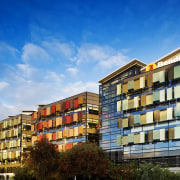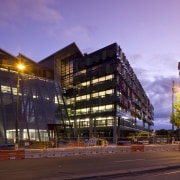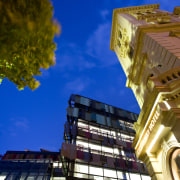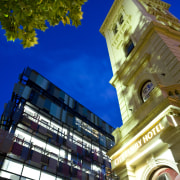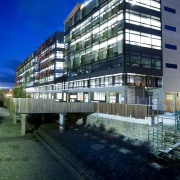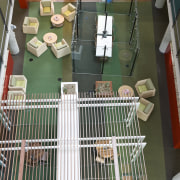Investment in tomorrow
Sustainability is a given for Bendigo Bank the bank was founded on sustainable economic and social principles. But it is the ESD features of the new HQ that are putting the bank in the limelight as it celebrates 150 years

Leading by example while many successful companies flee the regions to establish head offices in state capitals, one Victorian bank has renewed its commitment to the local community. Bendigo Bank has chosen to build its new headquarters right where it started business 150 years ago.
But the bank's commitment to social responsibility goes way beyond the interests of staff and the Bendigo community, important though these are. The bank is also committed to environmental sustainability its new headquarters sets a benchmark for sustainable office design.
Bendigo Bank managing director Rob Hunt says the bank's desire to follow world best practice for ESD is a natural progression of a philosophy that has shaped the bank for more than a century.
"The new building coincides with the bank's 150th anniversary, which is an appropriate time to reflect on our heritage," Hunt says. "Bendigo Bank was founded on the principles of economic and social sustainability the bank was originally a building society established in 1858 during the Bendigo goldrush. As such, it provided mortgages for members and helped to keep some of the gold wealth within the community. While dozens of other societies came and went, the Bendigo grew steadily, declaring a profit each year, even through the crises of the 1890s and 1930s depressions."
Hunt says that although the bank has since grown significantly and has merged with Adelaide Bank, it retains its strong social awareness.
"Helping to fund people into their own homes not only improves their circumstances it also improves circumstances of the entire community. Building the capacity of communities enhances our own success and demonstrates that doing the right thing' and creating good business outcomes can be absolutely aligned."
When Bendigo Bank decided to build its new headquarters, "doing the right thing" meant taking into consideration its staff, its local community and its responsibility to the natural environment.
The 15,000m² project, which was designed by Bligh Voller Nield Architecture and Gray Puksand, working with ESD consultancy Connell Wagner, comprises three buildings the existing Fountain Court and two new buildings linked by glass-walled skywalks.
"The complex was designed to create a development that refocuses the commercial hub of the city and draws people into the centre of Bendigo," says Hunt.
In keeping with the bank's desire to give something back to the people of Bendigo, the project includes two new open-air lanes connecting Bath Lane and High Street, and a new piazza Lyric Square, named after the former Lyric Theatre on site. There is also a wharf-style timber-decked pedestrian link adjacent to Bendigo Creek. This has been named Oscars Walk, in memory of local band leader Oscar Flight.
The ESD features are also putting the building in the limelight. Hunt says the ESD strategy aims to achieve significant performance improvements on a conventional building, while assisting in long-term savings through lower running costs. The building is predicted to consume half the energy of a typical office building, reduce potable water use by more than 50%, and allow for ease of maintenance, repair and replacement. This makes for a more sustainable building as materials won't need to be replaced as often.
Some of the ESD initiatives are evident at a glance. Colourful sunshades on the exterior help to visually break up the expanse of curtainwalling, but they also have a key environmental role to play. The sunshades act as an external second skin that cuts out up to 90% of heat, compared with just 10% for internal blinds. Double glazing also minimises solar gain in summer and insulates the building against the cold in winter.
The screens still allow plenty of natural light into the interior, which reduces the need for artificial lighting. The shades are used in conjunction with louvres that can be opened to provide flow-through ventilation and fresh air, reducing the air conditioning load.
The building incorporates one of the first large-scale applications of under-floor air (UFA) ventilation to be seen in Australia. This system provides significant advantages to ceiling-mounted delivery systems.
Rather than forcing air down on occupants, UFA conditioning provides fresh, clean air at low pressure, with many controls allowing individual customisation. The fans use less energy than in a traditional system, as the air is at lower pressure. Warm and polluted air is extracted at ceiling level.
As with many Australian cities, Bendigo has a drought-vulnerable water supply and often experiences extreme water restrictions. Consequently, several water-saving technologies have been introduced to the Bendigo Bank, including the installation of a recycling water treatment plant (RWTP).
The plant treats both black and grey water, and provides treated Class A water for use in toilet flushing. The RWTP uses a three-stage process whereby the water is mechanically filtered then biologically treated before being disinfected and stored in a 10,000-litre tank. No water from the reticulated supply is used for toilet flushing. This will result in 20,000 litres of wastewater treated per day, saving around 4.5 million litres of drinking water annually.
Further water savings will be made by the use of AAA-rated water-saving toilet flush devices, and tapware that ensures a minimal amount of water is used.
Rainwater is collected for use in the drip-fed irrigation system that supplies the extensive native landscaped gardens around the building. The water is filtered and stored in a 10,000-litre rooftop tank.
The landscaping has a key environmental role to play. As well as providing an attractive and natural backdrop, it contributes to the passive thermal comfort of the building. At least 60% of the planting stock is indigenous. The bank has also restored the degraded Bendigo Creek.
Low-VOC materials and finishes have been used throughout the fit-out. In addition, a clean, dust-free atmosphere is provided through a central vacuum cleaning system.
The building design also highlights the move towards a more open, interactive and transparent workplace. Open-plan office areas with narrow floor plates are designed to snake around large, central atriums. The atriums help to animate the interior and allow plenty of natural light into work areas.
Central staircases are positioned to promote staff interaction. Similarly, there are numerous breakout areas where staff can meet informally.
Hunt says major benefits predicted for the building include reduced staff sickness and increased productivity and wellbeing.
The building has also been designed to encourage staff to consider fuel-efficient transport options. More than a quarter of the parking space allocations are for small cars and motorcycles. In addition, 49 bicycle spaces have been allocated, including three for visitors. There are also shower and changing room facilities, and lockers for bicycle users.
For more details, contact Bendigo Bank, PO Box 480, Bendigo, Vic 3552, phone (03) 5485 7108, fax (03) 5485 7635. Website: www.bendigobank.com.au.
Story by: Trendsideas
Home kitchen bathroom commercial design
Diving into nature
Personality plus
Classic looks, contemporary efficiency

